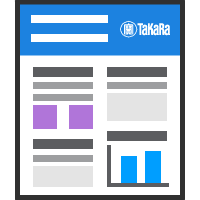Basic research on the activation of T cells has helped to elucidate associated biological phenomena such as the initiation of immune responses, thymocyte development, T-cell exhaustion, cellular signaling, and memory cell formation. This growing body of knowledge—applied to the development of adoptive cell therapies that harness bioactive T cells as treatments for various malignancies and infections—has driven significant advances in methods for ex vivo growth and manipulation of T cells.
Among a variety of different immune cell therapies that have shown promise, chimeric antigen receptor (CAR) T cells have provided durable responses for certain cancers (Reddy et al. 2020), such that several CAR-T therapies have gained regulatory approval, and many more are currently in preclinical and clinical stages of development. CAR-T cells are typically generated via genomic integration of a construct encoding an MHC-independent CAR specific for a tumor-associated antigen (Figure 1). CAR constructs are usually transduced into ex vivo patient or donor-derived T cells using recombinant retroviral or lentiviral vectors.

Figure 1. Normal T cell vs. CAR-T cell. Normal, unmodified T cells employ T-cell receptors (TCRs) to recognize and respond to MHC-presented antigens on the surface of neighboring target cells (e.g., tumor cells). In contrast, CAR-T cells are genetically modified to express chimeric antigen receptors (CARs), which typically employ single-chain variable fragment (scFv) domains to recognize antigens localized at the cell surface, in an MHC-independent manner.
Efficient modification of T cells by viral vectors is dependent upon a variety of factors, including the activation status of the cells at the time of transduction and the quality of the viral vectors used (Prommersberger et al. 2020). Activation status can affect T-cell growth and expansion, expression of the engineered receptor, and duration of anti-tumor responses.
Many different strategies have been developed to activate T cells, ranging from the use of nonspecific reagents such as the mitogen Phytohemagglutinin (PHA), to receptor-targeted methods using anti-CD3 or anti-CD28 monoclonal antibodies. PHA is a lectin that nonspecifically binds to the sugars on glycosylated T-cell receptors (TCRs), resulting in a low-level stimulation required for IL-2 expression (Chen et al. 2013). Antibodies against CD3 provide a strong proliferative signal via the TCR complex (signal 1), whereas anti-CD28, when delivered in tandem, provides additional costimulatory signals (signal 2) that further enhance the proliferative response. Accordingly, anti-CD3/CD28-coated magnetic beads and antibody tetramers have become widely used reagents for T-cell activation and expansion protocols.
A common experimental objective in the development of approaches for T-cell activation involves profiling different T-cell subtypes to assess the impacts of various activation methods and to evaluate the degree of T-cell responses. These analyses are typically performed via measurement of secreted cytokines using immunodetection methods such as ELISAs and bead or glass arrays, however, these can be cost-, time-, and/or labor-intensive approaches (Figure 2). Here we introduce GoStix Plus assays for cytokine analysis, which employ a lateral flow-based method that allows for reliable quantitation of human IL-2, IFN-γ, and TNF-α in approximately 10 minutes.

Figure 2. Timelines associated with commonly used methods for measuring cytokines. GoStix Plus: a lateral flow-based quantitation method. Fast ELISA: measurement using targeted, preformulated ELISA reagents. Standard ELISA: measurement using standard direct or indirect sandwich assay. Bead array: multiparametric measurement by flow cytometry of bead-based immunocapture of cytokines. Glass array: multianalyte measurement using quantitative, glass-slide multiplex ELISA microarray platform. Assay durations were taken from manufacturers' protocols.
To demonstrate the utility of GoStix Plus assays for rapid quantitation of cytokines in immune cell culture applications, primary human T cells were isolated from peripheral blood mononuclear cells (PBMCs) and activated using either of three different methods. Cell culture supernatants were harvested at regular intervals and analyzed for levels of IL-2, IFN-γ, and TNF-α using both GoStix Plus and ELISAs from a leading manufacturer. Results indicated that differing cytokine profiles associated with the respective activation methods could be reliably characterized using both methods.










